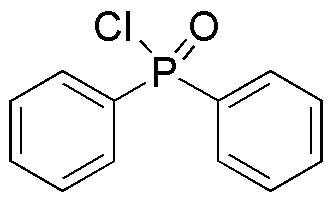Diphenylphosphorus oxychloride is widely utilized in research focused on:
- Synthesis of Organophosphorus Compounds: This chemical serves as an effective reagent in the synthesis of various organophosphorus compounds, which are essential in agricultural chemistry for developing pesticides and herbicides.
- Pharmaceutical Development: It plays a crucial role in the pharmaceutical industry by facilitating the synthesis of phosphonate derivatives, which are important in the development of antiviral and anticancer drugs.
- Polymer Chemistry: Used as a catalyst or reagent in polymerization processes, it helps in creating high-performance polymers with enhanced properties, benefiting industries like automotive and electronics.
- Analytical Chemistry: This compound is employed in analytical methods for detecting and quantifying phosphorous-containing compounds, aiding researchers in environmental monitoring and quality control.
- Flame Retardants: It is utilized in the formulation of flame retardant materials, providing safety in construction and textiles by reducing flammability and enhancing fire resistance.
General Information
Properties
Safety and Regulations
Applications
Diphenylphosphorus oxychloride is widely utilized in research focused on:
- Synthesis of Organophosphorus Compounds: This chemical serves as an effective reagent in the synthesis of various organophosphorus compounds, which are essential in agricultural chemistry for developing pesticides and herbicides.
- Pharmaceutical Development: It plays a crucial role in the pharmaceutical industry by facilitating the synthesis of phosphonate derivatives, which are important in the development of antiviral and anticancer drugs.
- Polymer Chemistry: Used as a catalyst or reagent in polymerization processes, it helps in creating high-performance polymers with enhanced properties, benefiting industries like automotive and electronics.
- Analytical Chemistry: This compound is employed in analytical methods for detecting and quantifying phosphorous-containing compounds, aiding researchers in environmental monitoring and quality control.
- Flame Retardants: It is utilized in the formulation of flame retardant materials, providing safety in construction and textiles by reducing flammability and enhancing fire resistance.
Documents
Safety Data Sheets (SDS)
The SDS provides comprehensive safety information on handling, storage, and disposal of the product.
Product Specification (PS)
The PS provides a comprehensive breakdown of the product’s properties, including chemical composition, physical state, purity, and storage requirements. It also details acceptable quality ranges and the product's intended applications.
Certificates of Analysis (COA)
Search for Certificates of Analysis (COA) by entering the products Lot Number. Lot and Batch Numbers can be found on a product’s label following the words ‘Lot’ or ‘Batch’.
*Catalog Number
*Lot Number
Certificates Of Origin (COO)
This COO confirms the country where the product was manufactured, and also details the materials and components used in it and whether it is derived from natural, synthetic, or other specific sources. This certificate may be required for customs, trade, and regulatory compliance.
*Catalog Number
*Lot Number
Safety Data Sheets (SDS)
The SDS provides comprehensive safety information on handling, storage, and disposal of the product.
DownloadProduct Specification (PS)
The PS provides a comprehensive breakdown of the product’s properties, including chemical composition, physical state, purity, and storage requirements. It also details acceptable quality ranges and the product's intended applications.
DownloadCertificates of Analysis (COA)
Search for Certificates of Analysis (COA) by entering the products Lot Number. Lot and Batch Numbers can be found on a product’s label following the words ‘Lot’ or ‘Batch’.
*Catalog Number
*Lot Number
Certificates Of Origin (COO)
This COO confirms the country where the product was manufactured, and also details the materials and components used in it and whether it is derived from natural, synthetic, or other specific sources. This certificate may be required for customs, trade, and regulatory compliance.


